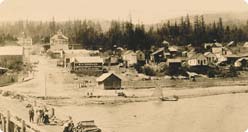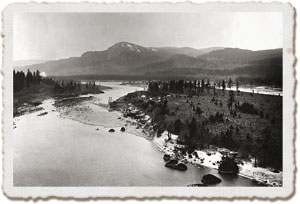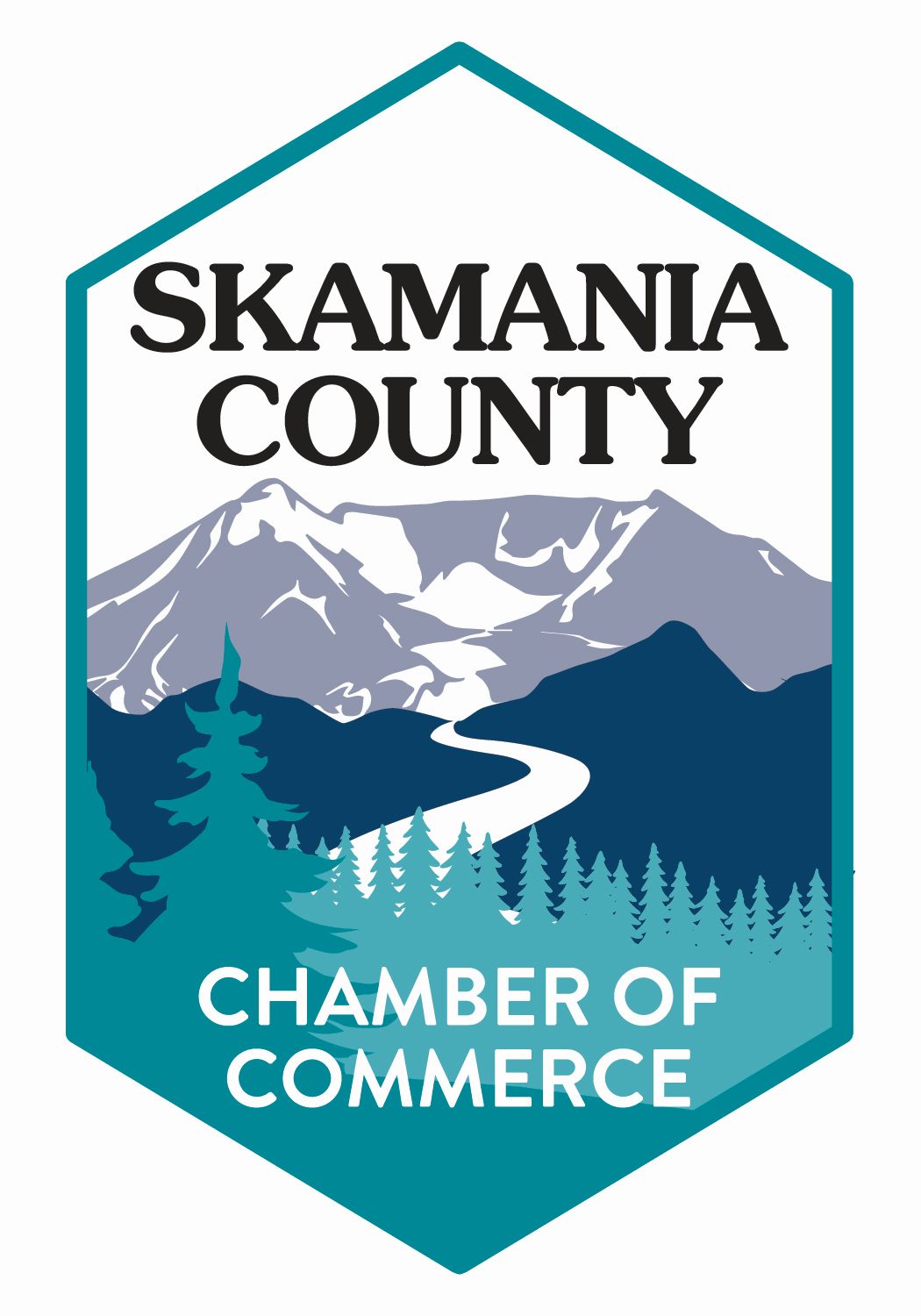History
Skamania County was formed in 1854 and the county government functioned in the former quartermaster residence of Fort Cascades. The government offices were subsequently moved to the port hospital within the compound itself. This building then served as the courthouse until 1893. Three wooden benches, one drop-leaf table and a few chairs completed the list of furniture. The reason for the move from the Lower Cascades to Stevenson in 1893 is not clear.
Late one night in 1893, in a dispute over rental fees, a suspect crew transported the county records from the town of Cascades to Stevenson. Stevenson became the county seat overnight. As it turned out, this move saved the county records because in 1894 the greatest recorded flood on the Columbia River destroyed every remaining building at the Fort. The town of Cascades was never rebuilt.
In 1850, Hamilton Island, originally named by Lewis & Clark “Strawberry Island,” became the site of the first portage railroad and the settlement of the Cascades and was swept away in the severe flood of 1894. Forty years later the community of North Bonneville developed as a construction town next to the massive Bonneville Lock, Dam and Powerhouse project, which began in late 1933.
In 1908, Stevenson was incorporated and the SP&S Railroad arrived, pushing the town up the hill away from the river. Streets were graded, wooden sidewalks constructed and the city asked residents to keep their cows from roaming the streets. Huge piles of logs were stacked along the waterfront to fuel the sternwheelers.
Mills and logging camps peppered the hillside, with flumes and skid roads to carry the logs to shipping points. Saloons flourished until prohibition went into effect. With the construction of the State Highway, and later construction of Bonneville Dam, the town moved further up the hill as portions of the original town site were flooded by the Bonneville Pool.
Strategically located just above the rapids known as the Upper Cascades, the Stevenson area has been home to Native American settlements for thousands of years. Their villages were focal points for commerce and social gatherings as they came to trade and fish along the river banks. Later the first explorers and missionaries used the Columbia River to penetrate the Cascade Mountains on their way to the Pacific Ocean. In 1843 the Oregon Trail brought the first of a great wave of settlers past our shores. Pioneers portaged around the Cascade Rapids on their way to the Willamette Valley.
Today, you can stroll along Stevenson’s riverfront parks where giant fish wheels once plied the Columbia River’s waters for salmon. Make sure you visit the world-class Columbia Gorge Interpretive Center Museum where you will be able to visualize and participate in the bountiful life and history of the Columbia River Gorge and Skamania County.
For more information on Skamania County, visit www.skamaniacounty.org.
Nestled between the Columbia River to the south, and the mountains and basalt cliffs of the Gorge to the north, the City of Stevenson offers a welcome respite from the noise and congestion of large cities. Take a stroll and explore the riverfront and downtown Stevenson. Visit our unique shops, galleries, restaurants and pub. You’ll discover a friendlier, laid back lifestyle-reminiscent of earlier decades.
Strategically located just above the rapids known as the Upper Cascades, the Stevenson area has been home to Native American settlements for thousands of years. Their villages were focal points for commerce and social gatherings as they came to trade and fish along the river banks. Later the first explorers and missionaries used the Columbia River to penetrate the Cascade Mountains on their way to the Pacific Ocean. In 1843 the Oregon Trail brought the first of a great wave of settlers past our shores. Pioneers portaged around the Cascade Rapids on their way to the Willamette Valley.
Some of these pioneers chose to stay. The Stevenson family, who settled in the Gorge in the 1800s from Missouri, founded the town of Stevenson on the old Shepard donation land claim. Under the auspices of the Stevenson Land Company, George Stevenson purchased the original town site for $24,000 in 1893, building the town along the lower flat near the river. Settlers expanded the original dock to serve the daily arrivals of sternwheelers unloading passengers, cargo and loading logs.

By 1900, many merchants established businesses. Locals could wet their whistles at the Iman or the Charles Thayer saloons. Travelers stayed at the Valley Hotel and Stevenson Hotel, and dined at the Hickey and Key Restaurant. Settlers shopped for staples at Totton’s General Store and Mitchell’s Drug Store that also housed the post office, courthouse, print shop and local jail.
Late one night in 1893, in a dispute over rental fees, a suspect crew transported the county records from the town of Cascades to Stevenson. Stevenson became the county seat overnight. In 1908 the town was incorporated and the SP&S Railroad arrived, pushing the town up the hill away from the river. Streets were graded, wooden sidewalks constructed and the city asked residents to keep their cows from roaming the streets. Huge piles of logs were stacked along the waterfront to fuel the sternwheelers.
Mills and logging camps peppered the hillside, with flumes and skid roads to carry the logs to shipping points. Saloons flourished until prohibition went into effect. With the construction of the State Highway, and later construction of Bonneville Dam, the town moved further up the hill as portions of the original town site were flooded by the Bonneville Pool.
Today, you can stroll along Stevenson’s riverfront parks where giant fish wheels once plied the Columbia River’s waters for salmon. Witness the myriads of colorful kiteboarders’ sails, as they jump and twist on the Columbia’s swells. Watch the ducks, geese and other waterfowl nesting at Rock Creek Cove. Browse through gift shops, antique stores and art galleries. And visit the Columbia Gorge Interpretive Center Musem to explore Native American legends, petroglyphs and artifacts telling the story of the Gorge. Return to a quieter time. Return to Stevenson.


For centuries the Columbia River Gorge has been used and inhabited by man, although not until the nineteenth century was the region opened up to a great influx of settlers and fortune seekers. In 1850, Hamilton Island, originally named by Lewis & Clark “Strawberry Island”, became the site of the first portage railroad and the settlement of the Cascades; swept away in the severe flood of 1894. Forty years later the community of North Bonneville, developed as a construction town next to the massive Bonneville Lock, Dam and Powerhouse project, which began in late 1933. Federal legislation in 1937 also authorized a second Powerhouse, although the need was not then immediate. North Bonneville was incorporated in 1935.
The Columbia River’s north shore, where North Bonneville had grown, was selected by federal agencies in 1971 as the site for the second Powerhouse. Faced with the prospect of being displaced and disbanded, the townspeople determined to relocate as a community. Intense efforts by citizens’ groups and planning assistance from state sources finally led to agreements with the U.S. Army Corps of Engineers to hire professionals for the design and construction of a new town. Contractors then prepared the chosen town site for the initial community of 600 people as the old town was devoured by the enormous excavation for the new powerhouse.
Efforts continue, with ongoing development, to grow in harmony with the enduring gorge settings. Modern facilities provided for the fully developed initial town ensure that community growth can continue without harm to this special environment. In March 1978, the transfer to the new town site was made, although much work still remained to be done. A major accomplishment of the Corps of Engineers’ second Powerhouse project was the complete relocation of the town of North Bonneville. The seven-year effort to relocate the residents and businesses of the town marked the first time that federal funds were spent to plan, design and develop a new community in connection with a water resource project.
Federal responsibility for the North Bonneville relocation was expanded in 1974 with enactment of Public Law 93-251, referred to as the McCormack Legislation. This law specifically broadened the Corps’ authority and obligation in relocation assistance to North Bonneville. The $35 million relocation project included raising the new town site above the 100-year flood plain, construction of streets, utilities, lighting, sewage system, water supply and sewage treatment plant, flood protection, parks, a central business district and all public buildings. Town siting required highway and railway relocation. And residents and business were furnished temporary housing until they could build their own permanent homes and facilities. The new town was built to accommodate 1500 residents. A celebration of the successful relocation was held July 29, 1978. To learn more about North Bonneville today, visit www.northbonneville.net.
By submitting this form, you are consenting to receive marketing emails from: . You can revoke your consent to receive emails at any time by using the SafeUnsubscribe® link, found at the bottom of every email. Emails are serviced by Constant Contact



















